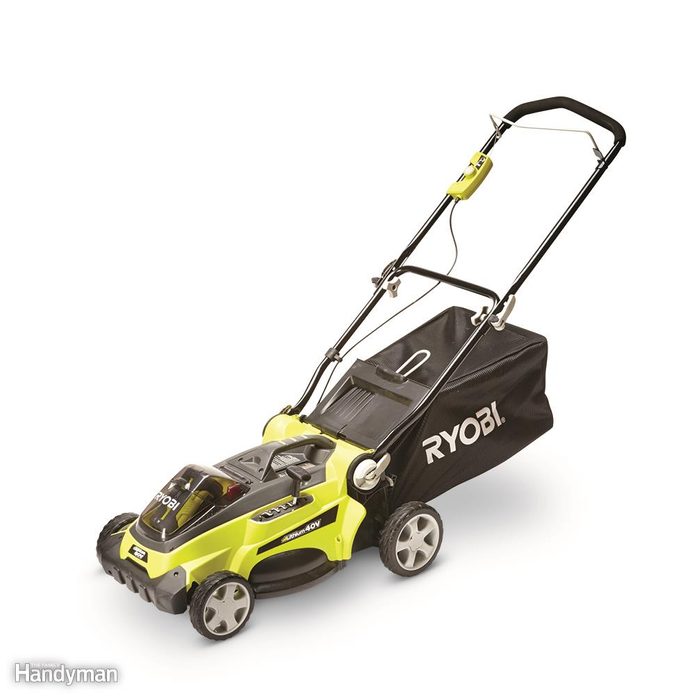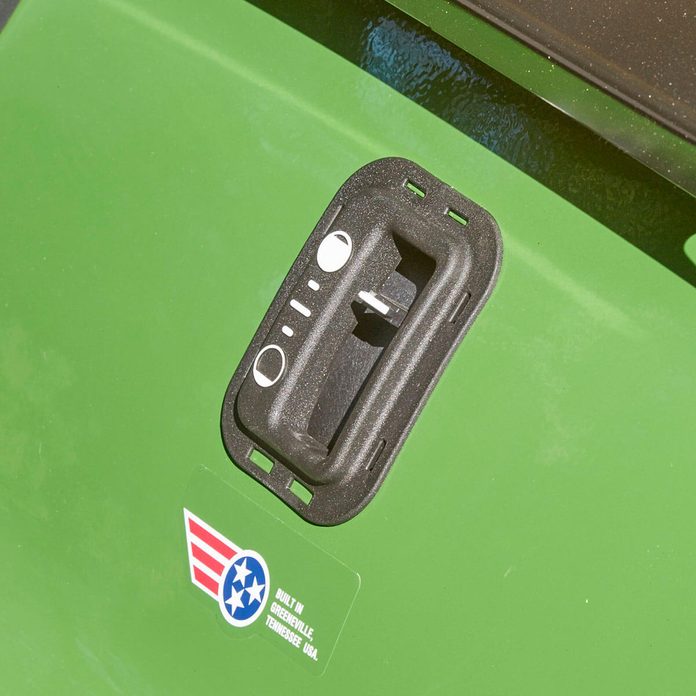
Performance
When you’re thinking about buying a lawn mower, you need to find the mower that matches up with what you need for your lawn. You’ll find that walk-behind mowers have engines that range from 140-cc to 190-cc. Pick the engine size that will handle tasks like cutting through tall grass, wet grass, leaf mulching and bagging.
There are several different engine styles out there, including a side valve engine, engines with overhead valves or a direct overhead valve. An overhead valve engine is quieter and has better fuel consumption typically, but it costs more. Bonus: If you’re shopping during holiday season, don’t miss these amazing lawn mower sales.

Comfort
You’re going to be walking behind the mower or riding it for years to come so you’d better make sure it’s comfortable. Make sure the walk-behind mower can be set at the right height for you or the tractor seat is firm enough for you. A stand-on mower is another option to consider.

Durability
Features like John Deere’s Easy Change Oil Filter are important to think about before buying a lawn mower. Are other parts easily replaceable like the air filter or how tough is it to replace the mower’s pull cord? If you know how to tune up a lawn mower you can get it to last a long time.

Electric Mowers
When deciding between electric vs. gas lawn mowers, consider the size of your lawn. If you don’t have a huge lawn, a battery-powered electric lawn mower may be perfect. Cordless mowers are quieter, require less maintenance, and of course, run without gas or oil. But best of all, you’ll never have to start a gas engine—you just push a button or lever and you’re mowing. Here are a few reasons why you should switch to electric lawn care.
As lithium-ion battery technology has improved, most manufacturers have included cordless mowers in their lineup, so you’ll have plenty of choices. Many of these mowers can cut an average suburban yard (about one-fifth of an acre) on a single charge. Prices for battery-powered mowers are similar to those of their gas-powered rivals, and you’ll find most of the same features, too.

Drive System
If your lawn is relatively flat and not huge, chances are you’ll be perfectly happy buying a push mower—that is, a mower that’s not self-propelled. In addition to being cheaper, mowers without power to the wheels are lighter, have fewer mechanical parts to wear out, and are usually easier to maneuver.
If you have hills or a large yard, a self-propelled mower is a better choice. Front wheel drive mowers pull the mower along but may lose traction on hills, where you tend to push down on the handle. And if you bag your grass, the weight of the bag will reduce the traction on the front wheels, making the drive wheels less effective. In most cases, rear- wheel drive is the best option since it works great on hills and with a bag. All-wheel drive is needed only for severely sloping terrain.
If you buy a self-propelled mower, consider upgrading to variable speed for more flexibility in matching your mowing speed to the lawn conditions and your walking speed.

Spending More Up Front
Residential, walk-behind lawn mowers range in price from less than $200 to well over $600. And you may be wondering if it’s worth spending top dollar on a mower. In addition to the extra features available on more expensive mowers, high-end mowers have better-quality components. You’ll find easy-rolling ball bearing wheels, long-lasting composite or aluminum decks, and top-quality engines. And most high-end mowers include a longer warranty, too. This adds up to a mower that will last longer and need fewer repairs. So you may save money by not having to replace or repair your old mower.

Online Reviews
Even a top-brand mower will occasionally have a quirky problem. One good way to discover whether the mower you’re considering has a hidden flaw is to check online reviews. You’ll find user reviews on manufacturer websites, Amazon and other websites where lawn mowers are sold. But keep in mind that there will always be a few users who have had a bad experience. Multiple complaints about the same problem should be a red flag, though.

Your Local Dealer
You may be able to save a little money by buying a lawn mower from a department store or home center. But buying from a local servicing dealer has advantages that might outweigh any cost savings. First, you’re more likely to get better purchasing advice from the more knowledgeable staff at a dealer showroom. And when it comes time for a tune-up or warranty repairs, you’ll know right where to go for convenient, personal service. Most dealers have at least two or three top-quality lawn mower brands to choose from and will display the most popular models on the showroom floor.

A Good Mulcher
If you mulch your grass, look for features like special mulching lawn mower blades or an aluminum or composite deck that resists grass buildup on the underside better than steel. If you prefer to bag your grass, make sure the bag is easy to remove and reinstall. And for the greatest versatility, look for a mower that also has a side discharge chute for times when you’ve let your grass grow too long for mulching or bagging. Some mowers have features like Toro’s ‘Bag On Demand’ that simplify the changeover from bagging to mulching. Honda makes a mower with a feature called Versamow that allows you to mulch and bag at the same time, and adjust the percentage of clippings that go into the bag.

Cutting Height Adjustment
Try out the height adjusters on the mower you intend to buy to make sure they work smoothly and easily. On some mowers, a single lever adjusts a pair of wheels or even all four wheels at once to make sure you are mowing at the right height.

Electric Start
If pulling a starter rope is difficult for you or anyone else who will be using the mower, look for a mower with an electric start. A built-in battery and starter motor eliminate the need to pull-start your mower. This is great for people with shoulder or strength problems. The electric start feature is also handy when you need to stop to empty the grass-catcher bag or pick up a stick that’s in the way. Just turn off the engine. Restarting is a button-push away. Honda even makes a mower that charges the battery while you mow, so you don’t ever have to plug in the mower to recharge the battery. You’ll spend about $100 more for the electric start feature.

Stop Without Restarting
If you collect your clippings and need to empty the bag frequently, or if you have to stop often to pick up sticks or move toys out of the way, you know what a hassle it can be to restart the lawn mower every time. You can avoid this problem by shopping for a mower with a blade brake clutch (BBC) or Toro’s Blade Override System (BOS). Mowers with either feature allow you to stop the blade but leave the engine running. Expect to pay about $100 more.

Lawn Tractors: Easy Deck Engagement
For safety reasons, the cutting blades don’t automatically spin at start-up; you have to engage them with a mechanical lever or an easy electric push-button. Some of the lever mechanisms are awkward or stubborn, so try before you buy.

Lawn Tractors: Get a Bumper
Trust us on this: You’re going to smack a tree someday, and that impact can destroy the hood. So plan on buying a lawn mower with a bumper or set aside some dough to buy an add-on bumper from the manufacturer. And if your little collision with the tree made your lawn mower not start, here’s how to fix it.

Lawn Tractors: Check the Hour Meter
All lawn tractors require maintenance based on hourly usage. A built-in hour meter takes all the guesswork out of maintaining your tractor. You can always add an hour meter later ($50), but the built-in models eliminate that hassle.

Lawn Tractors: Know Engine Size and Features
Lawn tractor engines are sized to match the mower deck and climb the grade listed in the manufacturer’s specs. Buying a lawn tractor with a larger engine won’t get you a higher top-end speed, but the larger engine is important if you plan to haul a cart or add a snow blade or a snow thrower accessory.
Most tractor engines have traditional carburetors. However, the Cub Cadet model shown above, has electronic fuel injection (EFI), which dramatically reduces the starting problems associated with carbureted engines and ethanol fuel. Plus, Cub Cadet claims its EFI system boosts fuel efficiency by 25 percent.

Mow-in-Reverse Mechanisms
Lawn tractors automatically stop blade movement the instant you shift into reverse. To mow in reverse, you have to hold in a button the entire time you’re mowing in reverse or turn the key to the reverse position and then reposition the key when you want to move forward. We slightly prefer the button system, but both are inconvenient.

Convenient Gas Gauge
Some models have a gas gauge you can check while driving, while others offer a see-through tank. The less expensive models require you to stop and lift the hood to check the fuel level. You’ll also want to be sure to empty out the gas in your lawn tractor before winter.

Rear-Engine Riding Mowers
Rear-engine riding lawn mowers do one thing: cut grass. Compared with lawn tractors, they’re less powerful, slower and cut a smaller swath (maximum width: 30 in.). At $800 to $1,400, they’re not always cheaper than a lawn tractor. The least expensive models are a good choice for smaller yards and limited storage space.
